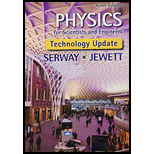
(a)
The slope of the straight line, including units.
(a)
Answer to Problem 6.49AP
The slope of the straight line is
Explanation of Solution
From the Figure, the terminal speed of the filters is
Formula to calculate the slope is,
Substitute
Conclusion:
Therefore, the slope of the straight line is
(b)
The theoretical slope of a graph of resistive force versus squared speed.
(b)
Answer to Problem 6.49AP
The theoretical slope of a graph of resistive force versus squared speed is
Explanation of Solution
Given info:
The expression for the resistive force is,
Here,
Formula to calculate the slope is,
Substitute
Conclusion:
Therefore, the theoretical slope of a graph of resistive force versus squared speed is
(c)
The drag coefficient of the filters.
(c)
Answer to Problem 6.49AP
The drag coefficient of the filters is
Explanation of Solution
Given info: Radius of the circle is
Formula to calculate the area of the circle is,
Here,
Substitute
Thus, the area of the circle is
Formula to calculate the drag coefficient is,
Here,
Substitute
Conclusion:
Therefore, the drag coefficient of the filters is
(d)
The vertical separation from the line best fit for the eight data point.
(d)
Answer to Problem 6.49AP
The vertical separation from the line best fit for the eight data point is
Explanation of Solution
Given info:
Form the Figure (1), the force at point 8 in the graph, the mass off the coffee is
Formula to calculate the force at point 8 is,
Substitute
The terminal speed of the filters is
The vertical separation from the line best fit for the eight data point is,
Conclusion:
Therefore, the vertical separation from the line best fit for the eight data point is
(e)
The explanation for what graph explains and compare it with the theoretical prediction.
(e)
Answer to Problem 6.49AP
The graph for the coffee filter falling in air at terminal speed shows the resistance force is a function of the terminal speed squared which gives the air resistance.
Explanation of Solution
Given info:
The drag coefficient of the filters is
Thus, the constant slope of the graph is,
The graph for the coffee filter falling in air at terminal speed shows the resistance force is a function of the terminal speed squared which gives the air resistance.
The expression for the resistive force is,
From this given expression,
Thus, the graph of the resistive force is directly proportional to the terminal speed squared.
Conclusion:
Therefore, the graph for the coffee filter falling in air at terminal speed shows the resistance force is a function of the terminal speed squared which gives the air resistance.
Want to see more full solutions like this?
Chapter 6 Solutions
Bundle: Physics for Scientists and Engineers, Technology Update, 9th Loose-leaf Version + WebAssign Printed Access Card, Multi-Term
- The rectangular loop of wire shown in the figure (Figure 1) has a mass of 0.18 g per centimeter of length and is pivoted about side ab on a frictionless axis. The current in the wire is 8.5 A in the direction shown. Find the magnitude of the magnetic field parallel to the y-axis that will cause the loop to swing up until its plane makes an angle of 30.0 ∘ with the yz-plane. Find the direction of the magnetic field parallel to the y-axis that will cause the loop to swing up until its plane makes an angle of 30.0 ∘ with the yz-plane.arrow_forwardA particle with a charge of − 5.20 nC is moving in a uniform magnetic field of (B→=−( 1.22 T )k^. The magnetic force on the particle is measured to be (F→=−( 3.50×10−7 N )i^+( 7.60×10−7 N )j^. Calculate the y and z component of the velocity of the particle.arrow_forwardneed answer asap please thank youarrow_forward
- 3. a. Determine the potential difference between points A and B. b. Why does point A have a higher potential energy? Q = +1.0 C 3.2 cm 4.8 cm Aarrow_forwardPls help ASAParrow_forward1. Explain the difference between electrical field, potential difference, and electrical potential differencearrow_forward
- Pls help ASAParrow_forward9. When an electron moves into a uniform and perpendicular magnetic field, it will.. a. Accelerate parallel to the magnetic Field until it leaves b. Accelerate in a circular path c. Accelerate perpendicular to both the magnetic field and its original direction d. Repel back into the electric field 10. If a proton at rest is placed in a uniform magnetic field with no electric or gravitational field around, the proton will…….. a. Accelerate in the direction of the magnetic field b. Accelerate in a direction perpendicular to the magnetic field c. Move in a circular path d. Not acceleratearrow_forward7. The electric field at a distance of 1.0 mfrom a charged sphere is 100 N/C. At what distance from thesphere will the electric field be 50 N/C? a. 1.1 m b. 1.4 m c. 2.0 m d. 4.0 m 8. The electric potential due to a point charge at a point depends on a. The direction of the electric field b. The distance from the point charge c. The velocity of the point charge d. The mass of the point chargearrow_forward
 Classical Dynamics of Particles and SystemsPhysicsISBN:9780534408961Author:Stephen T. Thornton, Jerry B. MarionPublisher:Cengage Learning
Classical Dynamics of Particles and SystemsPhysicsISBN:9780534408961Author:Stephen T. Thornton, Jerry B. MarionPublisher:Cengage Learning University Physics Volume 1PhysicsISBN:9781938168277Author:William Moebs, Samuel J. Ling, Jeff SannyPublisher:OpenStax - Rice University
University Physics Volume 1PhysicsISBN:9781938168277Author:William Moebs, Samuel J. Ling, Jeff SannyPublisher:OpenStax - Rice University Principles of Physics: A Calculus-Based TextPhysicsISBN:9781133104261Author:Raymond A. Serway, John W. JewettPublisher:Cengage Learning
Principles of Physics: A Calculus-Based TextPhysicsISBN:9781133104261Author:Raymond A. Serway, John W. JewettPublisher:Cengage Learning Physics for Scientists and Engineers: Foundations...PhysicsISBN:9781133939146Author:Katz, Debora M.Publisher:Cengage Learning
Physics for Scientists and Engineers: Foundations...PhysicsISBN:9781133939146Author:Katz, Debora M.Publisher:Cengage Learning
 AstronomyPhysicsISBN:9781938168284Author:Andrew Fraknoi; David Morrison; Sidney C. WolffPublisher:OpenStax
AstronomyPhysicsISBN:9781938168284Author:Andrew Fraknoi; David Morrison; Sidney C. WolffPublisher:OpenStax





